 W
WAcanthastrea echinata, commonly known as the starry cup coral, is a species of corals in the family Lobophylliidae. It is a wide-ranging species found from the western Indian Ocean, throughout the Pacific Ocean, and eastward to the southeastern Atlantic Ocean. It can inhabit any reef habitat to depths of 50 m. This species, which may become threatened with the global decline of coral reefs, is a popular coral used in aquariums.
 W
WAcropora aculeus is a species of acroporid corals found throughout the Indian Ocean, the central Indo-Pacific, Australia, southeast Asia, Japan and the East China Sea. It is also present in the western Pacific Ocean. It is an uncommon species and is particularly prone to coral bleaching, disease, and crown-of-thorns starfish predation; it is also harvested for use in aquaria, and the International Union for Conservation of Nature has assessed it as being a "vulnerable species". Habitat loss is a big concern.
 W
WAcropora cerealis is a species of acroporid coral found throughout the Indian and Pacific oceans, from the Red Sea and the Gulf of Aden to the Hawaiian Islands and the Johnston Atoll. It can be found on upper reef slopes in shallow tropical reefs, from depths of 3–20 m. Crown-of-thorns starfish preferentially prey upon Acropora corals, and this species is also harvested for the aquarium trade.
 W
WAcropora cytherea is a stony coral which forms horizontal table like structures. It occurs in the Indo-Pacific Ocean in areas with little wave action, favouring back reef environments from 3 to 20 m depth.
 W
WAcropora digitifera is a species of acroporid coral found in the Gulf of Aden, the Red Sea, the southwest and northern Indian Ocean, Australia, southeast Asia, the central Indo-Pacific, Japan, the west Pacific Ocean and the East China Sea. It is found in shallow areas of tropical reefs in the back margins, from depths of 0 to 12 m. It was described by Dana in 1846.
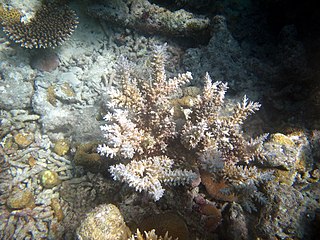 W
WAcropora echinata is a species of acroporid coral that was first described by Dana in 1846. Found in shallow, tropical, sheltered reefs in marine environments, it is found at depths of 8 to 25 m in clear water. The species is listed as vulnerable on the IUCN Red List, and has a decreasing population. It is not common but found over a large area, and is listed under CITES Appendix II.
 W
WAcropora globiceps is a species of acroporid coral found in the oceanic central and western Pacific Ocean and central Indo-Pacific. It can also be found in the Great Barrier Reef, the Philippines, the Andaman Islands, Polynesia, Micronesia and the Pitcairn Islands. It occurs on the slopes of reefs, the flats of reefs, in tropical shallow reefs, and at depths of around 8 metres (26 ft). It was described by Dana in 1846.
 W
WAcropora horrida is a species of acroporid coral that was first described by James Dwight Dana in 1846. Found in tropical, shallow reefs in marine environments, it occurs near fringing reefs around turbid water, at depths of 5 to 20 m. It is listed as a vulnerable species on the IUCN Red List, and it is thought to have a decreasing population. It is not common and found over a large area, and is listed under CITES Appendix II.
 W
WAcropora humilis, also known as finger coral, is a species of acroporid coral found in the Gulf of Aden, the Red Sea, the northern and southwestern Indian Ocean, Australia, the central Indo-Pacific, Japan, southeast Asia, the East China Sea, the central and western Pacific Ocean, the Johnston Atoll and the northwestern Hawaiian Islands. It also occurs in the Raja Ampat Islands, Mariana Islands, Palau, and the Pitcairn Islands. Occurring in tropical shallow reefs on upper reef flats and slopes at depths of up to 12 metres (39 ft), it was described by Dana in 1846.
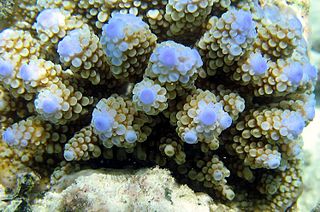 W
WAcropora nasuta is a species of branching stony coral in the family Acroporidae. It is native to the western and central Indo-Pacific where it is found in shallow reef habitats. Like other corals of the genus Acropora, it is susceptible to coral bleaching and coral diseases and the IUCN has listed it as being "Near Threatened".
 W
WAcropora robusta is a species of acroporid coral found in the Red Sea, the Gulf of Aden, the southwest and northern Indian Ocean, the central Indo-Pacific, Australia, Southeast Asia, Japan, the East China Sea and the oceanic west and central Pacific Ocean. It occurs in tropical shallow reefs, mainly along margins that are exposed to the action of strong waves, and can be found at depths from 1 to 8 metres. It was described by Dana in 1846.
 W
WAcropora tenuis is a species of acroporid coral found in the Red Sea, the Gulf of Aden, the southwest, northwest and northern Indian Ocean, the Persian Gulf, the central Indo-Pacific, Australia, Southeast Asia, Japan, the East China Sea and the oceanic west and central Pacific Ocean. It occurs in tropical shallow reefs on upper slopes and in subtidal habitats, at depths of 8 to 20 metres.
 W
WAcropora valida is a species of acroporid coral found in the Red Sea, the Gulf of Aden, the southwestern, northwestern and northern Indian Ocean, the Persian Gulf, the central Indo-Pacific, Australia, southeast Asia, Japan, the East China Sea, the oceanic western, central and far eastern Pacific Ocean, the northwestern Hawaiian Islands and Johnston Atoll. It occurs in tropical shallow reefs in a variety of reef habitats, at depths of 1 to 15 metres.
 W
WAlveopora spongiosa is a species of stony coral that is found in the Red Sea, the Gulf of Aden, the southwest and northern Indian Ocean, the central Indo-Pacific, Australia, Southeast Asia Japan, the East China Sea and the oceanic west and central Pacific Ocean. It can be found on protected upper coral reef slopes, generally from depth of 9–20 m, but can grow at depths of up to 50 m. It is moderately susceptible to coral bleaching, and is harvested for the aquarium trade.
 W
WThe branch coral is a species of acroporid coral found in the southwest and northern Indian Ocean, the central Indo-Pacific, Australia, Southeast Asia, Japan and the East China Sea, Cook Islands and the oceanic west Pacific Ocean. It can be found in shallow reefs on the reef tops, walls and slopes to depths of 30 m.
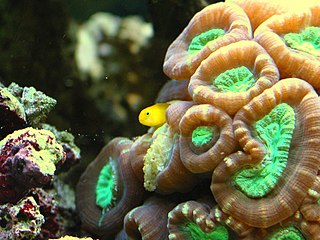 W
WCaulastraea furcata, also known as the candy cane, trumpet, or bullseye coral, is a species of large stony coral in the family Merulinidae.
 W
WDipsastraea pallida is a species of colonial stony coral in the family Merulinidae. It is found in tropical waters of the Indian and Pacific Oceans. This is a common species of coral with a widespread distribution, and the main threat it faces is from the destruction of its coral reef habitats. It is rated as a "least-concern species" by the International Union for Conservation of Nature. This species was first described in 1846 as Favia pallida by the American zoologist James Dwight Dana; it was later transferred to the genus Dipsastraea, but some authorities continue to use the original name.
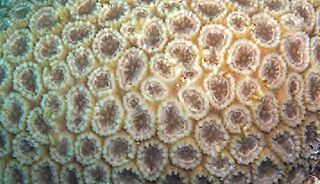 W
WDipsastraea speciosa is a species of colonial stony coral in the family Merulinidae. It is found in tropical waters of the Indian and Pacific oceans.
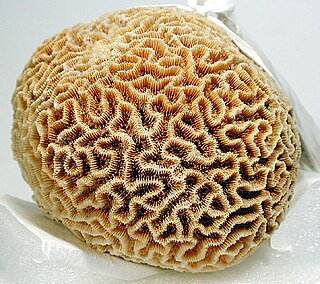 W
WGoniastrea favulus, also known as the lesser star coral, is a species of stony coral in the family Merulinidae. It occurs in shallow water in the Indo-Pacific region. This is an uncommon species of coral and the International Union for Conservation of Nature has rated its conservation status as being "near threatened".
 W
WGoniastrea stelligera, commonly known as knob coral, is a species of stony coral in the family Merulinidae. It occurs in shallow water on the coast of East Africa and in the Indo-Pacific region. This is a common species of coral but it seems to be decreasing in abundance. The main threat it faces is from the destruction of its coral reef habitat, and it is also moderately susceptible to coral bleaching, so the International Union for Conservation of Nature has rated its conservation status as being "near threatened".
 W
W W
WLithophyllon repanda is a species of mushroom or disc coral in the family Fungiidae.This species is able to move to another location on occasion. The International Union for the Conservation of Nature (IUCN) rated it as a least-concern species and it was originally described by Dana in 1846. It occurs at depths of 1 to 30 metres.
 W
WLobophyllia costata, common name Lobed cactus coral, is a species of large polyp stony coral in the family Lobophylliidae.
 W
WMontipora capitata, commonly known as rice coral or pore coral, is a stony coral in the family Acroporidae. It is a reef building species and is found in tropical parts of the Pacific Ocean.
 W
WMontipora digitata, also known as finger coral, is a species of stony coral. It is found in shallow water in East Africa, the Indo-West Pacific, Kenya, Mozambique and Rodriguez.
 W
WPavona decussata, sometimes known as leaf coral, is a species of colonial stony coral in the family Agariciidae. It is found in shallow water in various reef habitats, particularly on gently sloping surfaces, in tropical parts of the western and central Indo-Pacific region.
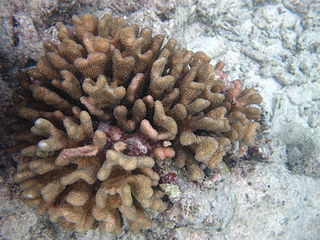 W
WPocillopora elegans is a species of colonial stony coral in the family Pocilloporidae. It is native to tropical and subtropical parts of the western, central and eastern Pacific Ocean. It is susceptible to bleaching and various coral diseases and the International Union for Conservation of Nature (IUCN) has listed it as a "vulnerable species".
 W
WPocillopora grandis, is a colonial species of stony coral in the family Pocilloporidae. It is known commonly as antler coral, and is found in the Indo-West Pacific to the Eastern Tropical Pacific.
 W
WPocillopora meandrina, commonly known as cauliflower coral, is a species of coral occurring in the Indo-Pacific and Pacific oceans. This coral lives in shallow reef environments.
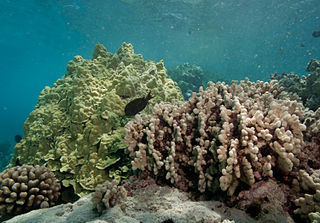 W
WPorites compressa, also known as finger coral or hump coral, is a species of marine stony coral in the family Poritidae. It is found growing on coral reefs and in shallow lagoons in tropical parts of the Indian and Pacific Oceans.
 W
WPorites cylindrica, commonly known as hump coral, is a stony coral of the subclass Hexacorallia.
 W
WPorites lobata, known by the common name lobe coral, is a species of stony coral in the family Poritidae. It is found growing on coral reefs in tropical parts of the Indian and Pacific Oceans.
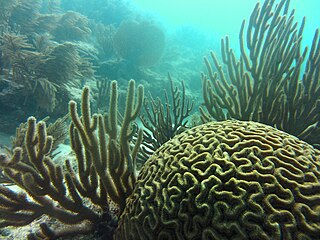 W
WPseudodiploria strigosa, the symmetrical brain coral, is a colonial species of stony coral in the family Mussidae. It occurs on reefs in shallow water in the West Atlantic Ocean and Caribbean Sea. It grows slowly and lives to a great age.
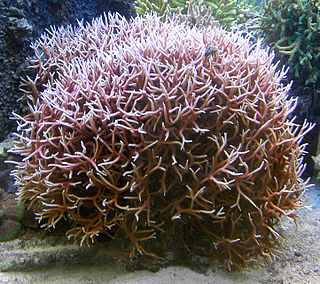 W
WSeriatopora hystrix is a species of colonial stony coral in the family Pocilloporidae. It forms a branching clump and is commonly known as thin birdsnest coral. It grows in shallow water on fore-reef slopes or in sheltered lagoons, the type locality being the Red Sea. It is native to East Africa, the Red Sea and the western Indo-Pacific region. It is a common species and the International Union for Conservation of Nature has assessed its conservation status as being of "least concern".